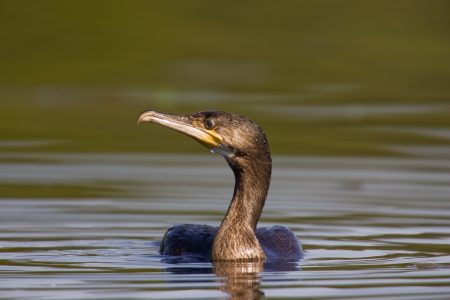
Photo credit: Mike Brown
As the summer starts to pick up speed, you might find yourself heading down to the beach to cool off. Keep an eye on the sea when you’re there, and you might spot a cormorant (Phalacrocorax carbo) out on a fishing trip.
Cormorants are common seabirds, although they’re often mixed up with the closely related shag, which is similar in appearance. The differences between shags and cormorants are almost completely arbitrary, as the birds are in the same family. The ‘distinction’ is simply based on whether or not the bird has a crest–shags do, cormorants don’t.
The name ‘cormorant’ is derived from the Latin word for ‘sea raven’, because people thought they were like aquatic crows. In reality, cormorants are more closely related to pelicans, and their overall body shape is a very ancient one. The oldest known fossil of a modern bird was most likely aquatic and resembles a cormorant (although it probably wasn’t actually one).
Being fish-eaters, cormorants are at home wherever the water is deep enough for them to hunt, whether saltwater or freshwater. In Ireland, if you see a long-necked black bird with webbed feet and short wings near inland bodies of water, it’s probably a cormorant. Our common shags tend to stick more to the coasts.
Regardless of where you find them, you’re more likely to see a cormorant swimming than flying. They’re adapted to dive in search of prey, with short wings that make flying take a lot of effort and energy. Thanks to their webbed feet and streamlined body plan, cormorants are good swimmers, capable of chasing fish down and grabbing them in their long, hooked beak.
One of the cormorant’s most well-known behaviours is its habit of standing by the water’s edge with its wings outstretched. This iconic posture is done to dry the wings out after swimming, since the oils covering the bird’s feathers can’t completely keep water out over extended dives. And cormorants certainly do make extended dives: around 6 metres deep for 30 seconds at a time.
Unlike other diving birds such as gannets, which dive by plunging into the water from the air, cormorants dive directly from the surface. Should you see a cormorant out fishing, you’ll likely see the bird go down, pop up somewhere else, and then go down again after a little break until they catch something. Since they’re so well-adapted for swimming and finding fish underwater, cormorants are very successful hunters.
This success has earned them the ire of humans in the past. Cormorants were thought of as competitors to fishermen, and hunted to the point that they were threatened with extinction. Nowadays, conservation efforts mean that the cormorant has bounced back, and the species is now thriving with a large population.
Of course, not everyone saw the cormorant’s fishing skill as a threat. In some places, mostly Japan and China, cormorants were trained to fish for humans by restricting their ability to swallow the largest fish they caught, so the fisherman could keep them instead. Nowadays, this practice is done more for tourism than as an industry, but cormorants still hold importance to those who fish alongside them.
Cormorants make frequent appearances in heraldry, where the iconic wing-drying posture is seen to represent the Christian cross and used as a symbol of sacrifice and nobility. They also feature in many cultures’ myths and legends, being seen as good omens in some Scandinavian countries and as the disguised souls of people lost at sea.
Cormorants may not be especially rare or flashy birds, but they’re very good at what they do, and something about them clearly captures the imagination. Next time you’re by the sea, keep an eye out for them, and you might be lucky enough to see one hauling up a catch.
By Grace Bettayeb, 17/06/22